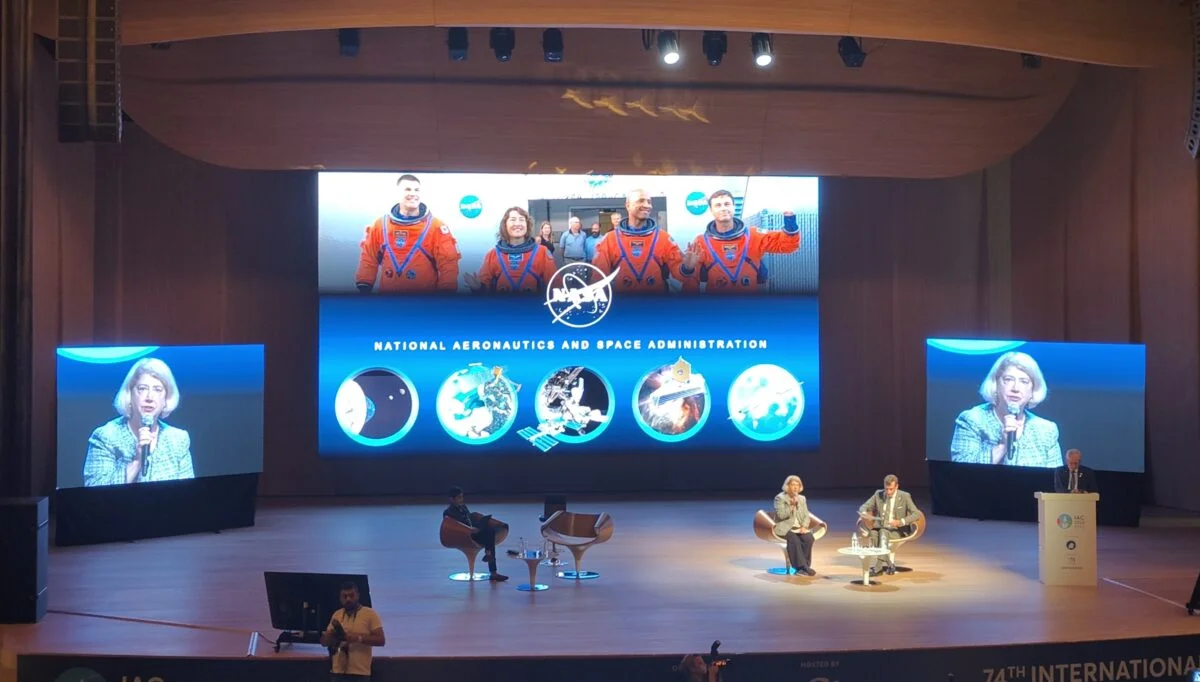China, Japan and NASA updated their Moon mission plans
- October 4, 2023
- 0
The opening of the first day of the IAC Congress in Baku – 50 years since the city last hosted such an event – was accompanied by a
The opening of the first day of the IAC Congress in Baku – 50 years since the city last hosted such an event – was accompanied by a

The opening of the first day of the IAC Congress in Baku – 50 years since the city last hosted such an event – was accompanied by a series of discussions as part of a combined session of heads of institutions on October 2. Not only representatives of the European Space Agency were present at the session.
NASA Deputy Administrator Pam Melroy told International Astronautical Federation (IAF) President Clay Maury that work is underway to build equipment not only for the Artemis 2 mission, but also for Artemis 3 and Artemis 4. On September 25, NASA announced that four RS-25 engines for the Artemis 2 mission were structurally coupled to the SLS rocket main unit.
Melroy also added that the mission team was recently in San Diego on the US West Coast for ocean rescue training after Orion’s landing. They also visited the Kennedy Space Center and toured the launch pad. The assistant manager noted progress on equipment conditions.
Melroy said that the Lunar Consortium Group (LSIC), which includes companies and organizations working on technologies for Moon missions, has more than 3,000 participants from 57 countries.
Li Guoping, chief engineer of the China National Space Agency (CNSA), talked about China’s recent achievements. A mission to return samples from the moon is planned next year using the Chang’e-6 automatic station on the far side of the moon, Li said. The Queqiao-2 relay satellite will be first launched in March next year to provide communications.
The Chang’e-7 and Chang’e-8 missions will take place in 2026 and 2028, respectively. They will include several spacecraft and will target the south polar region of the Moon. Chang’e-8 will conduct on-site sourcing technology tests and carry the 200 kilogram payload of international teams. This will pave the way for the construction of an international lunar research station, which will begin construction in the 2030s and be completed between 2035 and 2040. China is also working to send astronauts to the Moon by 2030.
The International Lunar Research Station (ILRS) will be based on the Chang’e-6, 7 and 8 missions. Lee said ILRS is fully open to collaboration and is currently in talks with potential partners. The project is expected to be completed in 2035-2040.
Hiroshi Yamakawa, President of the Japan Aerospace Exploration Agency (JAXA), said that the mission to land the device on the moon has passed an important stage. The Intelligent Lander for Exploring the Moon (SLIM) spacecraft managed to perform an orbital maneuver on September 30. The device’s main engine operated for 39 seconds at an altitude of approximately 660 km above the Atlantic Ocean. SLIM is expected to approach the Moon on October 4. However, it will pass by the Moon in a fuel-saving orbit and attempt to land on the Moon’s surface in January 2024.
Yamakawa also said that they are working on a joint soft landing mission to the moon with the Indian Space Research Organization (ISRO). Japan will provide the launcher and rover for the mission, while ISRO will provide the lander.
JAXA is also working with Toyota to build a rover that will carry two astronauts. ISRO Chairman S. Somanath talked about the recent success of Chadrayaan-3 mission. This mission in August made India the fourth country to make a soft landing on the moon.
Source: Port Altele
As an experienced journalist and author, Mary has been reporting on the latest news and trends for over 5 years. With a passion for uncovering the stories behind the headlines, Mary has earned a reputation as a trusted voice in the world of journalism. Her writing style is insightful, engaging and thought-provoking, as she takes a deep dive into the most pressing issues of our time.